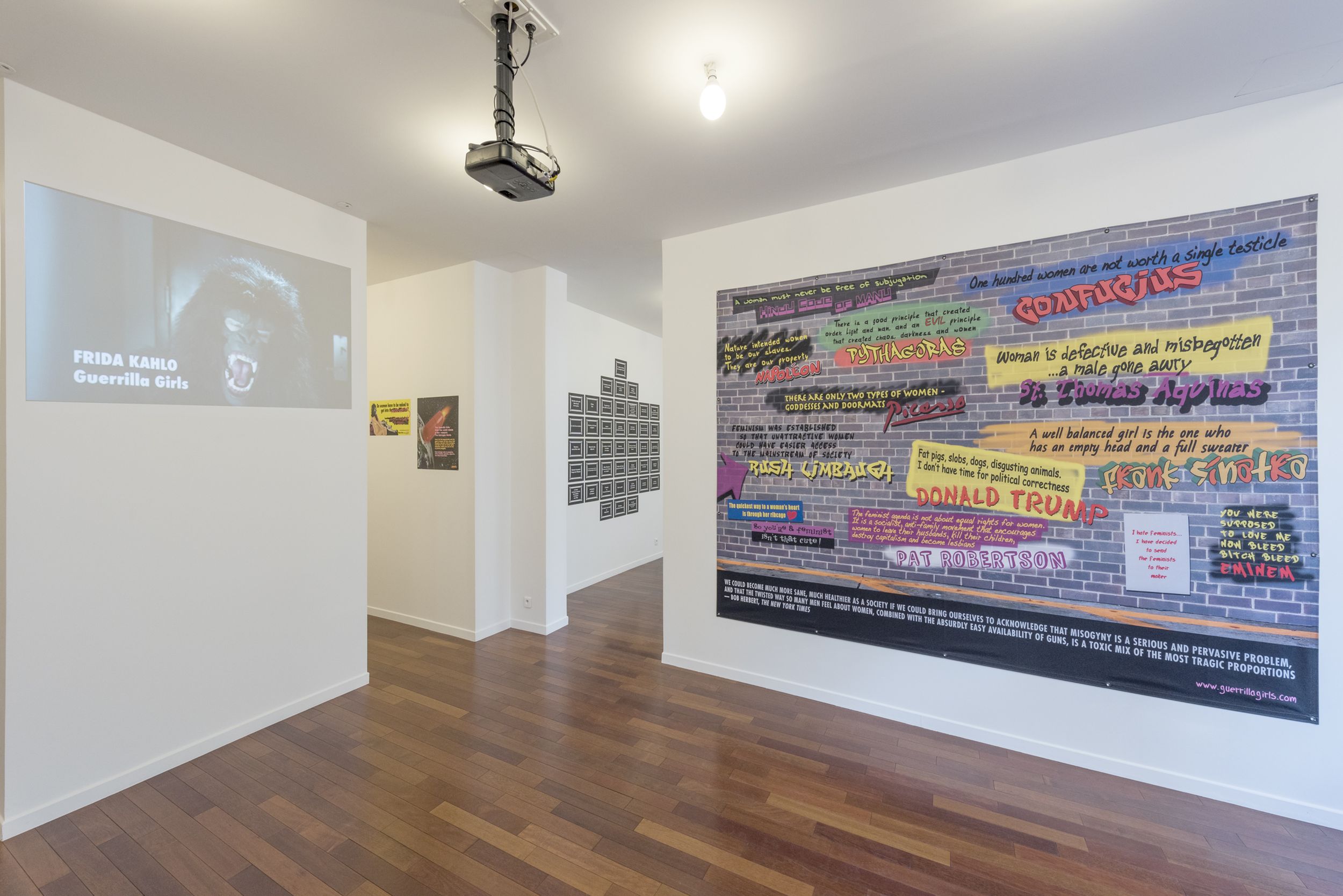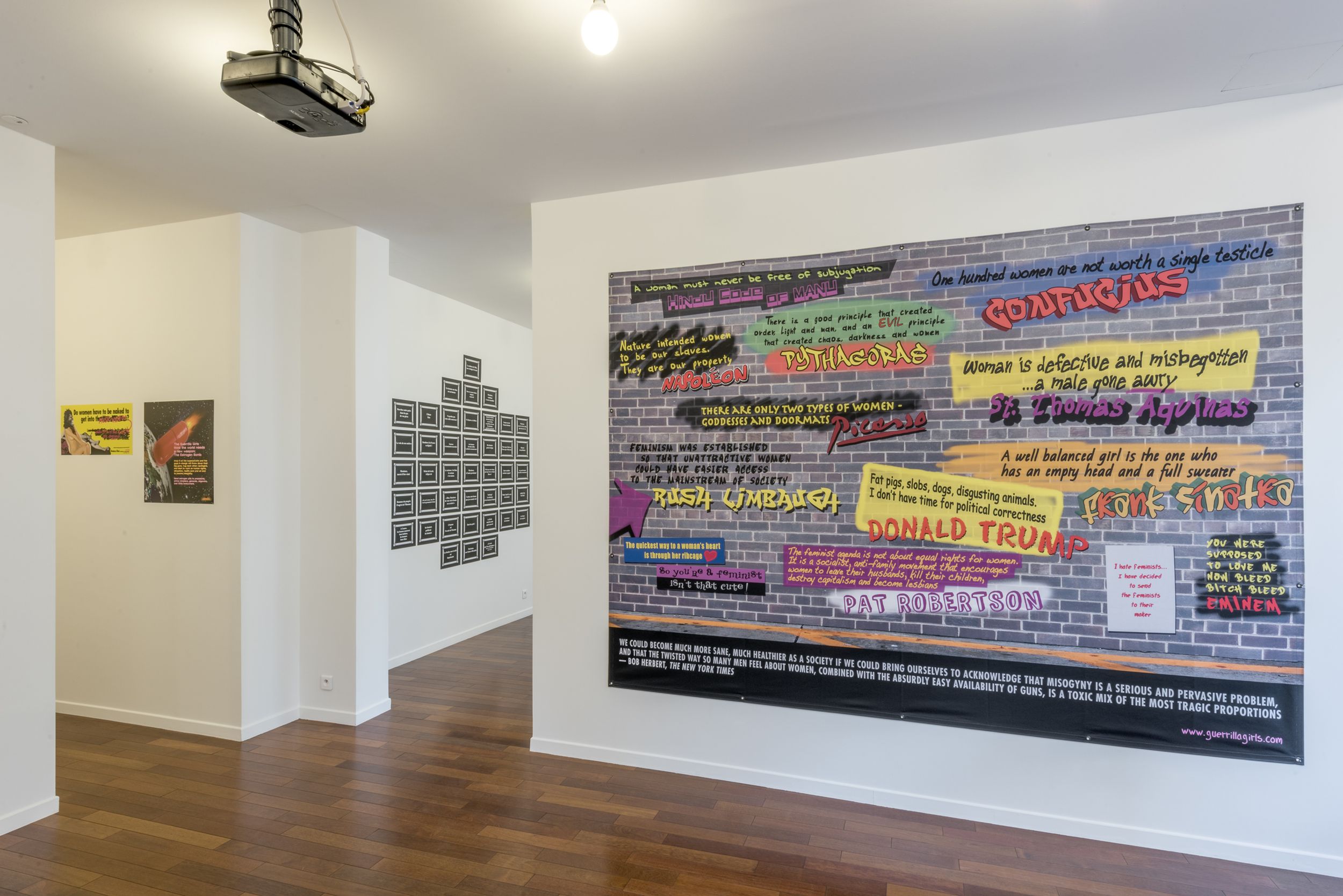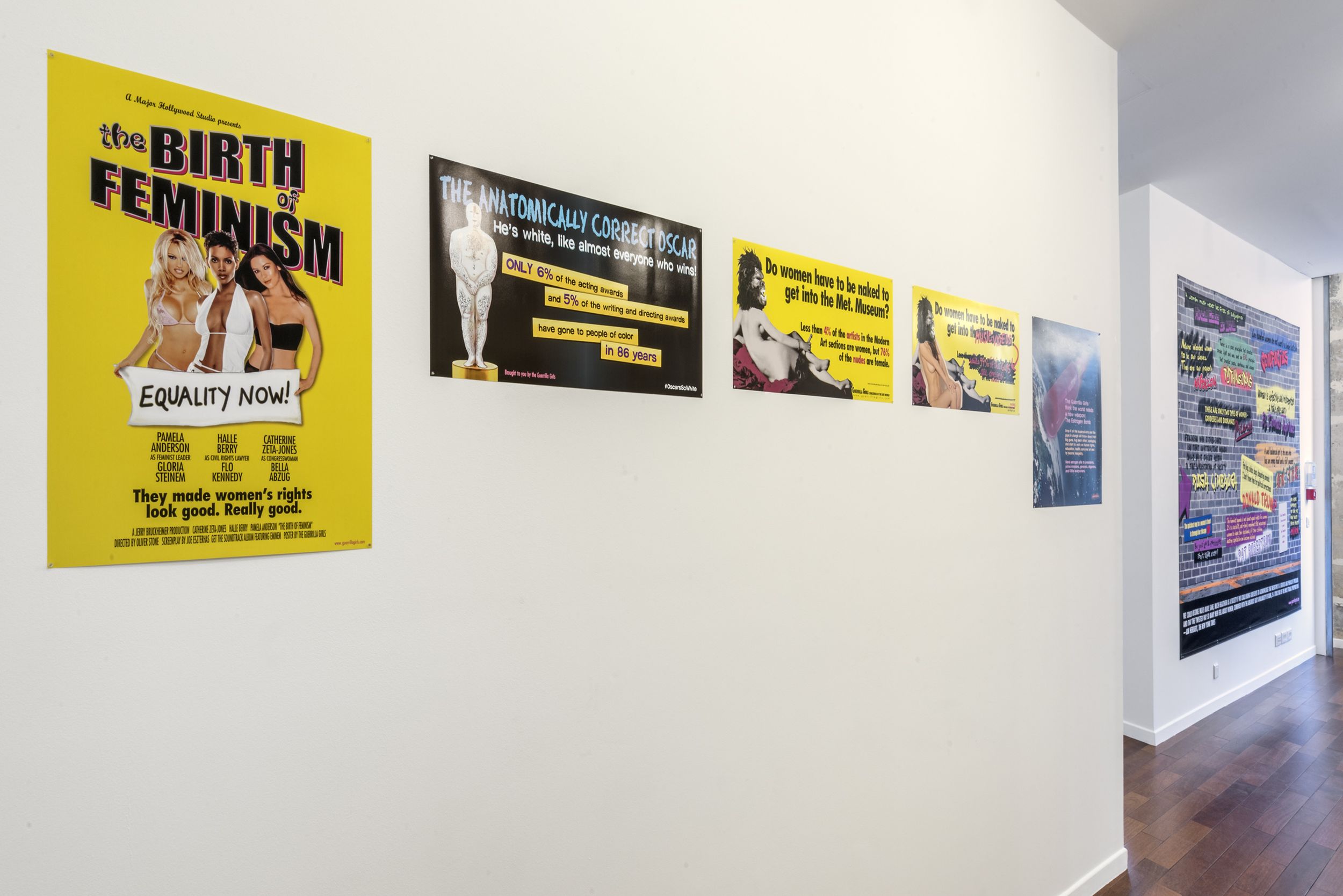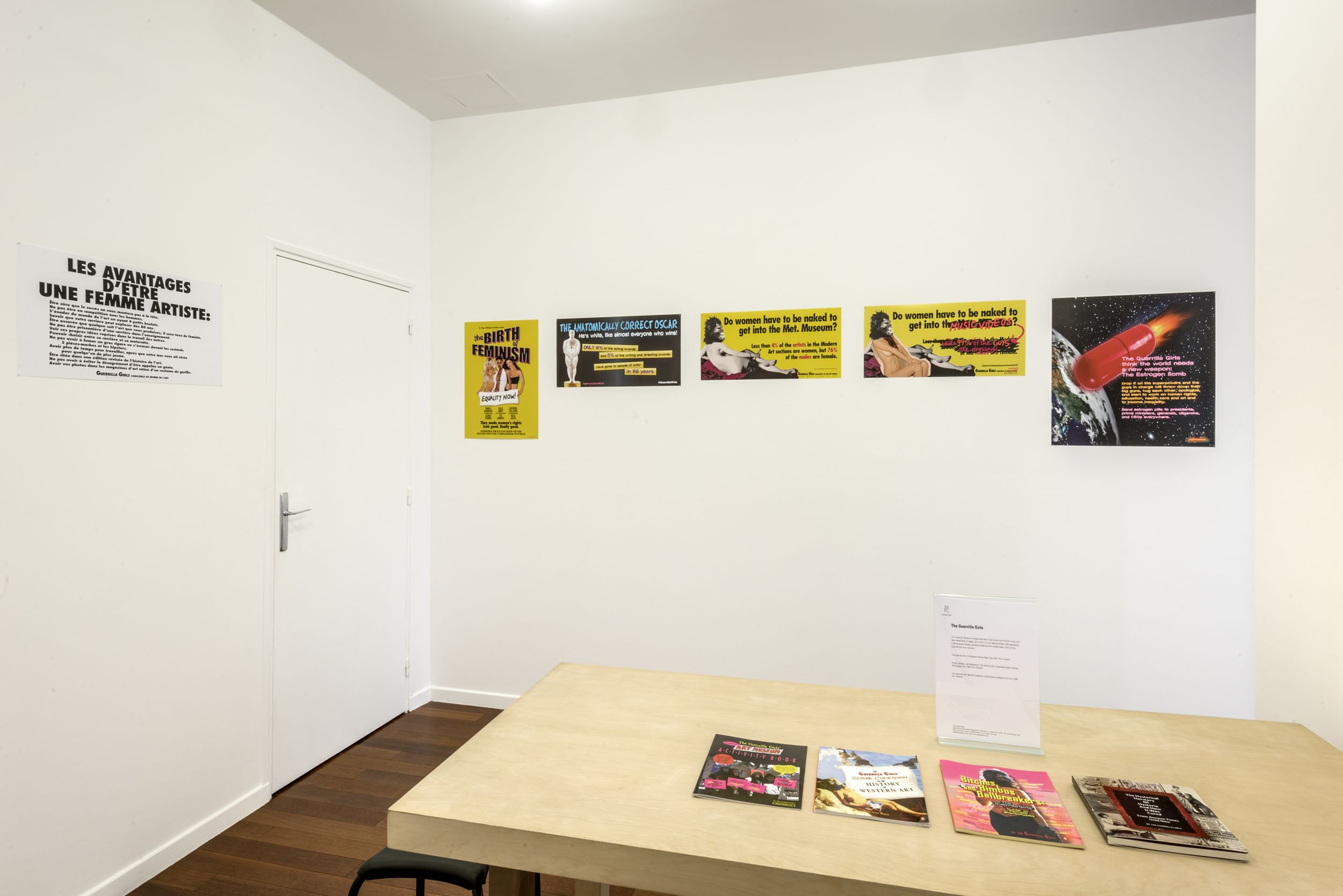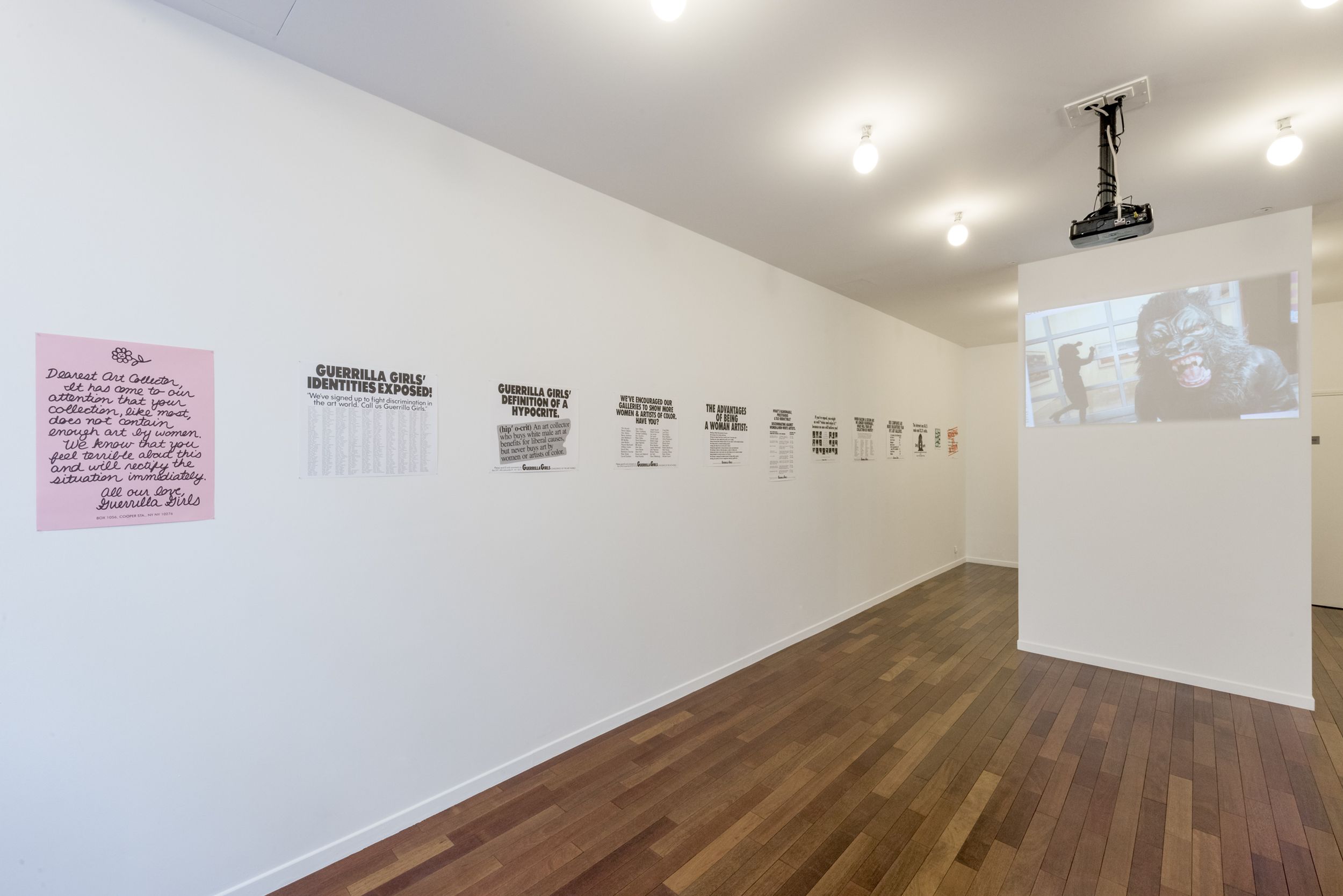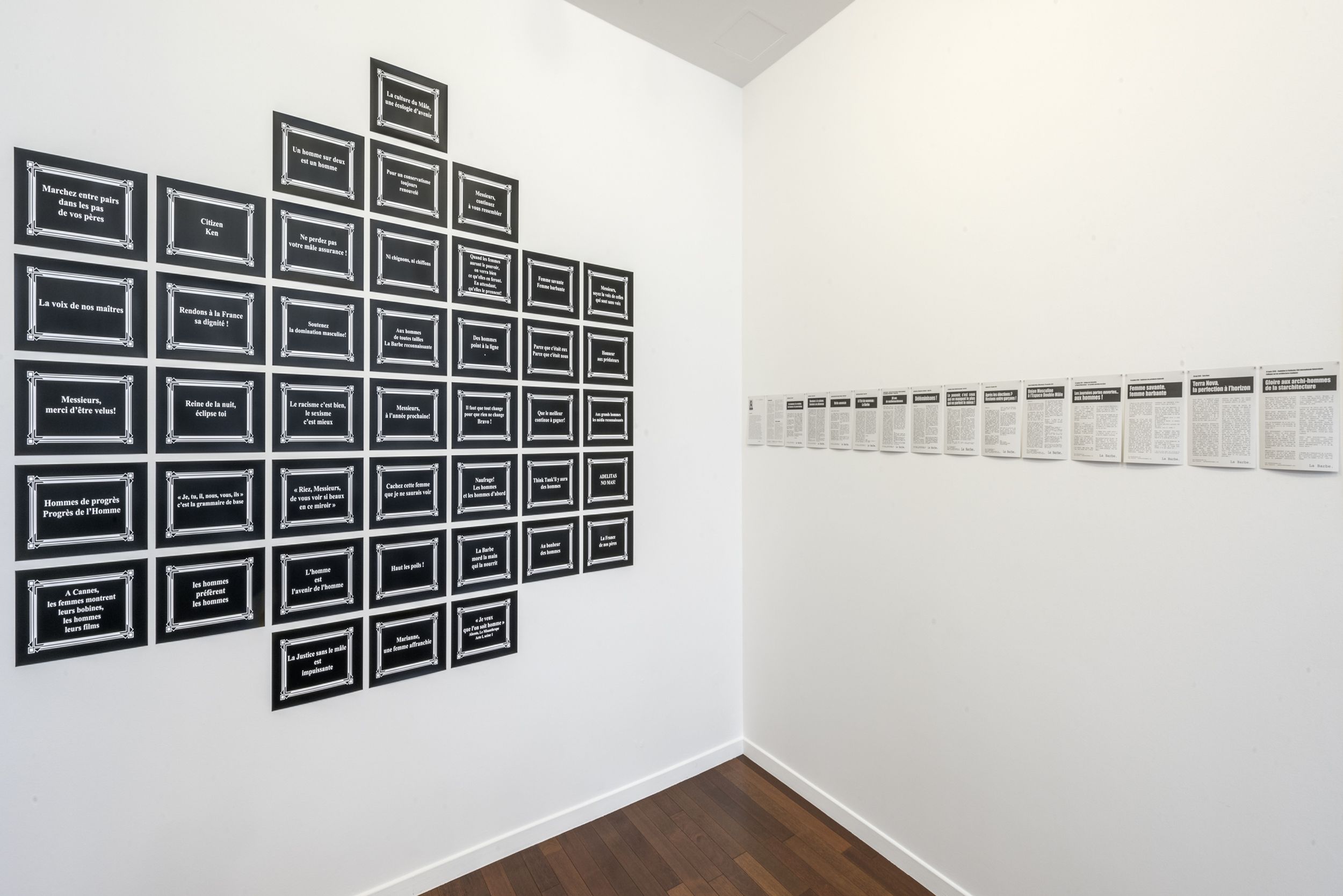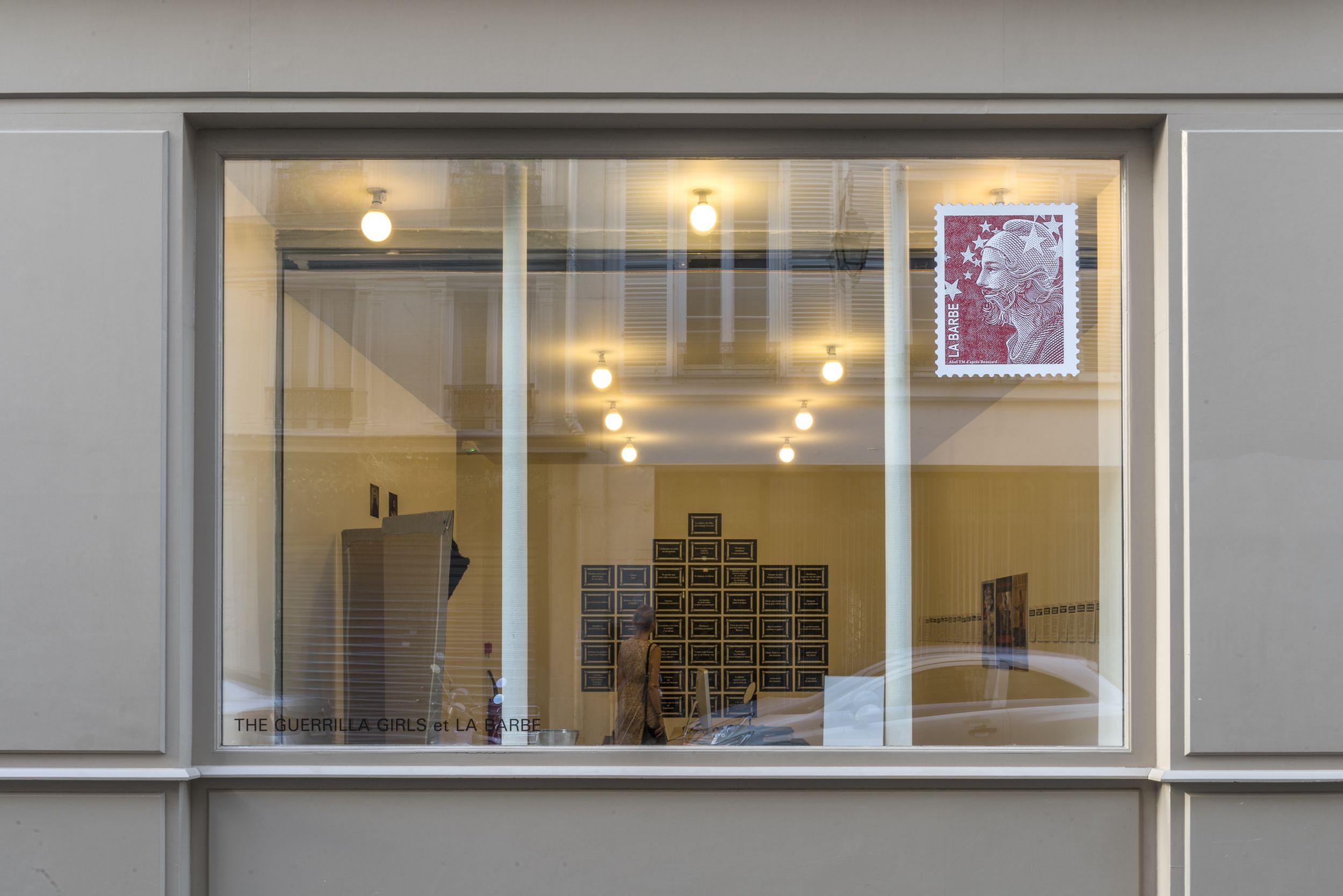The Guerrilla Girls - The Guerrilla Girls et La Barbe - Exhibitionmfc-michèle didier | Paris - Brussels - PARIS
Exhibition from September 9 to November 12, 2016.
Opening on Thursday September 8, 2016 in the presence of The Guerrilla Girls and La Barbe.
Conference on 9 september, 2016.
The gorilla and the beard or the art of going to war.
But against whom and with what?
The gallery’s new season will be inaugurated with an exhibition revisiting the aesthetics of militant feminist groups and to do so has extended an invitation to two of them: The Guerrilla Girls and La Barbe.
Whilst not forgetting their reason for taking up arms nor the enemy they are fighting, from the 9th of September to the 22nd of October 2016 at mfc-michèle didier, we will instead put their tools of combat on show.
Although they need no introduction, it seems right to quickly recall the roots of two activist groups who, armed with piliferous postiches, took up the gauntlet against any bylaws on bristle!
In 1985, The Guerrilla Girls made a startling observation: of the 169 artists featured in the MoMA exhibition An International Survey of Recent Painting and Sculpture, only a small minority were women or artists of colour.
From that moment on the group unceasingly created poster campaigns, handouts, leaflets and other ephemera in the aim of "opening the public eye to the discrimination which reigns within our very phallo- and ethno-centric artistic institutions"1.

Their printed matter is most often used in the context of actions taking place in public spaces. Pasting up posters in the street and handing out flyers or manifestos allow The Guerrilla Girls to reach a wider audience, but direct contact with the general public also exposes them to confrontation and the risk of violent reactions from opponents who wish to silence them.
Keeping in mind their will to communicate with the masses, these “Bad Girls” employ simple yet striking visual codes. Their texts are as succinct and incisive as advertising slogans and are systematically typeset in capital letters and bold or ultra-bold fonts. The posters are printed in flashy colours and one can clearly observe a penchant for girly pinks, yellow, red and black. Images are directly plundered from archetypal scenes of art history and radically set against monochrome backgrounds by means of brash digital cutouts, free of any secondary and superfluous information.
The group’s clever use of iconography is epitomized in the figure of the gorilla, a mask of which members don before each intervention. After all, there’s just a hair’s breadth between “guerrilla” and “gorilla”2.
The mask acts both as signature and disguise, allowing The Guerrilla Girls to hide their true identities while riffing on well-known gender-normative superheroes whom we need not name. The Guerrilla Girls’ first intention is to save the art world from its prime enemies: sexism and racism.
The mask provides a place for anonymity in their struggle. It hides each member’s identity and therefore protects him or her from any consequences that might be detrimental to their careers as artists or to their private lives. But if it is to be considered as an accessory or an element of camouflage, the mask can also become comical or ironic. This use of humour allows a “toning-down of a precarious situation; one in which the representation of women artists in museums is stagnating at around 11% and that of artists of colour is even more ludicrous”3.
Choosing a primate as your emblem is of course far from anodyne. While monkeys are often considered comical due to their mimetic nature4, the gorilla comes across as menacing or threatening and potentially aggressive. The long, sharp incisors of the Guerrilla Girls’ masks clearly illustrate this point. And so we are in agreement: their opinion must be heard.
Once again, of course, it’s the mask that allows this amazing feat. The listener’s attention is concentrated on the words spoken and not on the identity of he/she speaking. The content we see or rather read on The Guerrilla Girls’ posters and handouts is not relegated to a position of secondary importance behind an individual’s identity. Discourse prevails here.
In addition to the printed ephemera covering the gallery walls, mfc-michèle didier will be launching a new The Guerrilla Girls publication entitled The Hysterical Herstory of Hysteria and How It Was Cured.
This edition takes the form of a “board book”; its thick pages remind us of children’s educational volumes while offering a didactic and satirical reading of the history of a neurosis considered to affect only the fair sex.
As one Guerrilla may well hide another, mfc-michèle didier has invited the members of the feminist action group La Barbe (quite literally, The Beard) to join the gallery’s ranks for the duration of the exhibition.
The bearded feminists of La Barbe whose goal it is to “render visible masculine domination in the highest spheres of power, in all the domains of professional, political and cultural life by ridiculing their codes, their values and their group spirit”5 are not only active in the cultural sector. Their wide social struggle is clearly illustrated by their list of “targets” which one can read on their website: to art and culture they add “politics, business, media, the public services, education and research, think tanks, sport, religion and humanitarian aid”6.
Once again, their actions are simple and are claimed as such. The barbues (the bearded ladies) wish to “invade spaces which are traditionally dominated by men whilst wearing beards.”
So, as for The Guerrilla Girls, hair is an important element. Not necessarily in its animality but in its masculinity. The facial hairpiece worn by the group symbolises the dominance of men and the power they exert. Notably fashionable until the Second World War, the practice of beard wearing was intrinsically linked to political, economical and social status of men at that time. The aesthetics of the French Third Republic (1870-1940) which the group employ are present across the ensemble of their means of communication. Starting, obviously, with their name, La Barbe.
This age-old exclamation, “La barbe!”7 is used by the French when bothered or annoyed by someone or something and actually comes across as a little outmoded or antiquated. It appears as a slogan in white letters on the black banner brandished by the barbues at each of their interventions illustrating how visual language is put to use within their struggle.
The same can be said of the intertitles inserted into their films in post-production8. These black typographical slides were originally used in silent movies to present dialogues or explain the situation on screen and date back to the nineteenth century. The dance-hall accordions and piano scores present in their films originate from the same era and also uphold La Barbe’s Third Republic aesthetics.
We could continue by mentioning their penchant for vintage photographs or fairground attractions but the best way to understand La Barbe is quite simply to wear a beard! To this end, a beard-making workshop will take place at the gallery, accompanied by a life-size photo-panel into which the visitor is invited to insert their beardy head for a photo opportunity, confirming their support for the group. Indeed, we are not born bearded but become it.
In conclusion, to go to war, accessories are de rigueur. So forward march, everyone!
1. Sonia Recasens, Guerrilla Girls / La preuve que les féministes ont le sens de l’humour, Elles@centrepompidou. http://elles.centrepompidou.fr/blog/?p=748 (published on 12/04/2010)
2. The story goes that at an early group meeting, one member made a spelling mistake, writing “Gorilla” instead of “Guerrilla.”
3. Sonia Recasens, ibid.
4. We can’t help but think of the expression “to monkey around”
5. Qui sommes-nous ?, http://labarbelabarbe.org
6. Cibles, http://labarbelabarbe.org
7. “Quelle barbe !” or “La barbe!” could be translated as “Oh! What a drag!” or “enough is enough!”
8. The barbues try to systematically document each of their interventions. Photography and film allow them to record and control the dissemination of their combat.
ON FRIDAY SEPTEMBER 9th from 2pm to 6pm the gallery has organized a conversation between The Guerrilla Girls, La Barbe, Deborah De Robertisand Femen. This conversation was held at the Maison des Auteurs in Paris (7, rue Ballu, 75009).
Marc Donnadieu, Fabienne Dumont and Camille Morineau intervened during the meeting.
Exhibition from September 9 to November 12, 2016.
Opening on Thursday September 8, 2016 in the presence of The Guerrilla Girls and La Barbe.
Conference on 9 september, 2016.
The gorilla and the beard or the art of going to war.
But against whom and with what?
The gallery’s new season will be inaugurated with an exhibition revisiting the aesthetics of militant feminist groups and to do so has extended an invitation to two of them: The Guerrilla Girls and La Barbe.
Whilst not forgetting their reason for taking up arms nor the enemy they are fighting, from the 9th of September to the 22nd of October 2016 at mfc-michèle didier, we will instead put their tools of combat on show.
Although they need no introduction, it seems right to quickly recall the roots of two activist groups who, armed with piliferous postiches, took up the gauntlet against any bylaws on bristle!
In 1985, The Guerrilla Girls made a startling observation: of the 169 artists featured in the MoMA exhibition An International Survey of Recent Painting and Sculpture, only a small minority were women or artists of colour.
From that moment on the group unceasingly created poster campaigns, handouts, leaflets and other ephemera in the aim of "opening the public eye to the discrimination which reigns within our very phallo- and ethno-centric artistic institutions"1.

Their printed matter is most often used in the context of actions taking place in public spaces. Pasting up posters in the street and handing out flyers or manifestos allow The Guerrilla Girls to reach a wider audience, but direct contact with the general public also exposes them to confrontation and the risk of violent reactions from opponents who wish to silence them.
Keeping in mind their will to communicate with the masses, these “Bad Girls” employ simple yet striking visual codes. Their texts are as succinct and incisive as advertising slogans and are systematically typeset in capital letters and bold or ultra-bold fonts. The posters are printed in flashy colours and one can clearly observe a penchant for girly pinks, yellow, red and black. Images are directly plundered from archetypal scenes of art history and radically set against monochrome backgrounds by means of brash digital cutouts, free of any secondary and superfluous information.
The group’s clever use of iconography is epitomized in the figure of the gorilla, a mask of which members don before each intervention. After all, there’s just a hair’s breadth between “guerrilla” and “gorilla”2.
The mask acts both as signature and disguise, allowing The Guerrilla Girls to hide their true identities while riffing on well-known gender-normative superheroes whom we need not name. The Guerrilla Girls’ first intention is to save the art world from its prime enemies: sexism and racism.
The mask provides a place for anonymity in their struggle. It hides each member’s identity and therefore protects him or her from any consequences that might be detrimental to their careers as artists or to their private lives. But if it is to be considered as an accessory or an element of camouflage, the mask can also become comical or ironic. This use of humour allows a “toning-down of a precarious situation; one in which the representation of women artists in museums is stagnating at around 11% and that of artists of colour is even more ludicrous”3.
Choosing a primate as your emblem is of course far from anodyne. While monkeys are often considered comical due to their mimetic nature4, the gorilla comes across as menacing or threatening and potentially aggressive. The long, sharp incisors of the Guerrilla Girls’ masks clearly illustrate this point. And so we are in agreement: their opinion must be heard.
Once again, of course, it’s the mask that allows this amazing feat. The listener’s attention is concentrated on the words spoken and not on the identity of he/she speaking. The content we see or rather read on The Guerrilla Girls’ posters and handouts is not relegated to a position of secondary importance behind an individual’s identity. Discourse prevails here.
In addition to the printed ephemera covering the gallery walls, mfc-michèle didier will be launching a new The Guerrilla Girls publication entitled The Hysterical Herstory of Hysteria and How It Was Cured.
This edition takes the form of a “board book”; its thick pages remind us of children’s educational volumes while offering a didactic and satirical reading of the history of a neurosis considered to affect only the fair sex.
As one Guerrilla may well hide another, mfc-michèle didier has invited the members of the feminist action group La Barbe (quite literally, The Beard) to join the gallery’s ranks for the duration of the exhibition.
The bearded feminists of La Barbe whose goal it is to “render visible masculine domination in the highest spheres of power, in all the domains of professional, political and cultural life by ridiculing their codes, their values and their group spirit”5 are not only active in the cultural sector. Their wide social struggle is clearly illustrated by their list of “targets” which one can read on their website: to art and culture they add “politics, business, media, the public services, education and research, think tanks, sport, religion and humanitarian aid”6.
Once again, their actions are simple and are claimed as such. The barbues (the bearded ladies) wish to “invade spaces which are traditionally dominated by men whilst wearing beards.”
So, as for The Guerrilla Girls, hair is an important element. Not necessarily in its animality but in its masculinity. The facial hairpiece worn by the group symbolises the dominance of men and the power they exert. Notably fashionable until the Second World War, the practice of beard wearing was intrinsically linked to political, economical and social status of men at that time. The aesthetics of the French Third Republic (1870-1940) which the group employ are present across the ensemble of their means of communication. Starting, obviously, with their name, La Barbe.
This age-old exclamation, “La barbe!”7 is used by the French when bothered or annoyed by someone or something and actually comes across as a little outmoded or antiquated. It appears as a slogan in white letters on the black banner brandished by the barbues at each of their interventions illustrating how visual language is put to use within their struggle.
The same can be said of the intertitles inserted into their films in post-production8. These black typographical slides were originally used in silent movies to present dialogues or explain the situation on screen and date back to the nineteenth century. The dance-hall accordions and piano scores present in their films originate from the same era and also uphold La Barbe’s Third Republic aesthetics.
We could continue by mentioning their penchant for vintage photographs or fairground attractions but the best way to understand La Barbe is quite simply to wear a beard! To this end, a beard-making workshop will take place at the gallery, accompanied by a life-size photo-panel into which the visitor is invited to insert their beardy head for a photo opportunity, confirming their support for the group. Indeed, we are not born bearded but become it.
In conclusion, to go to war, accessories are de rigueur. So forward march, everyone!
1. Sonia Recasens, Guerrilla Girls / La preuve que les féministes ont le sens de l’humour, Elles@centrepompidou. http://elles.centrepompidou.fr/blog/?p=748 (published on 12/04/2010)
2. The story goes that at an early group meeting, one member made a spelling mistake, writing “Gorilla” instead of “Guerrilla.”
3. Sonia Recasens, ibid.
4. We can’t help but think of the expression “to monkey around”
5. Qui sommes-nous ?, http://labarbelabarbe.org
6. Cibles, http://labarbelabarbe.org
7. “Quelle barbe !” or “La barbe!” could be translated as “Oh! What a drag!” or “enough is enough!”
8. The barbues try to systematically document each of their interventions. Photography and film allow them to record and control the dissemination of their combat.
ON FRIDAY SEPTEMBER 9th from 2pm to 6pm the gallery has organized a conversation between The Guerrilla Girls, La Barbe, Deborah De Robertisand Femen. This conversation was held at the Maison des Auteurs in Paris (7, rue Ballu, 75009).
Marc Donnadieu, Fabienne Dumont and Camille Morineau intervened during the meeting.
